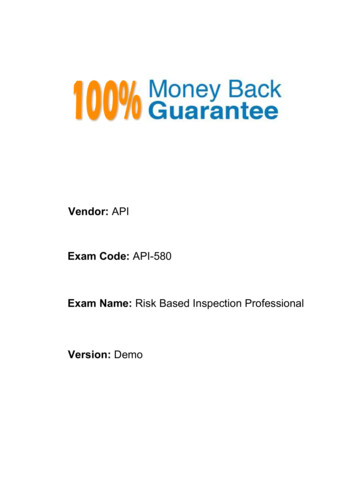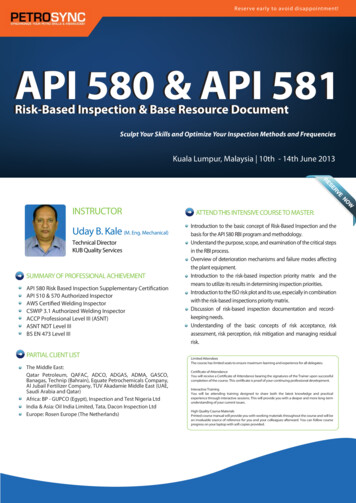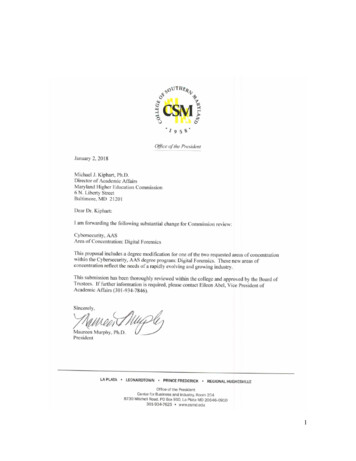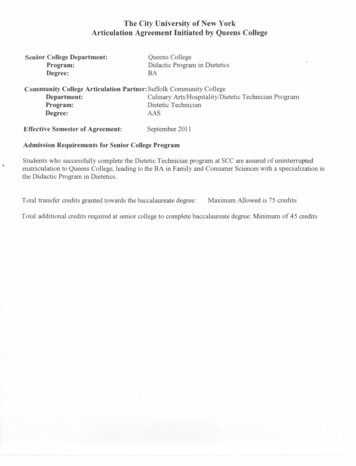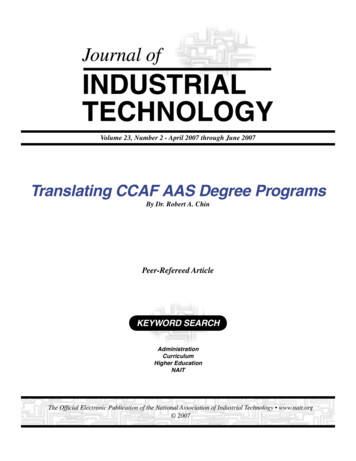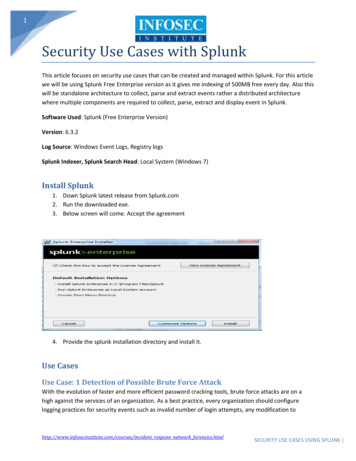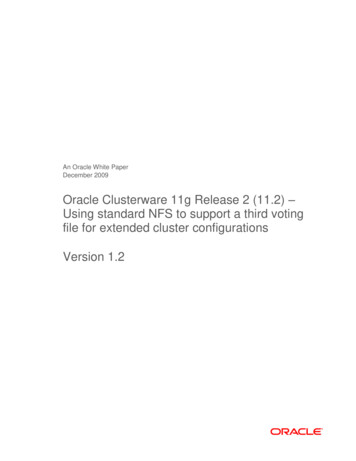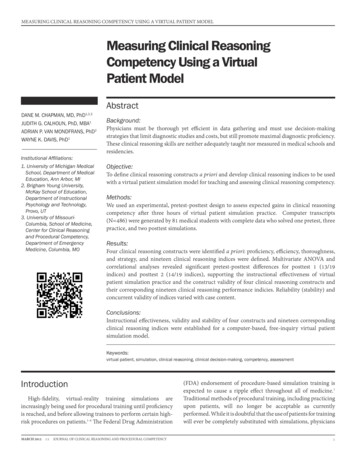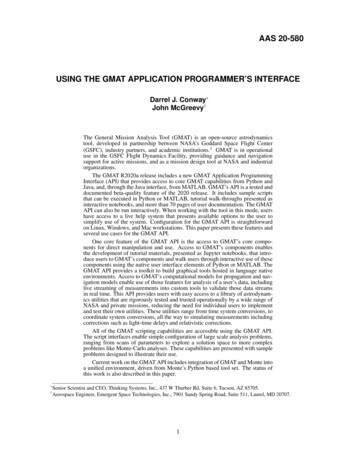
Transcription
AAS 20-580USING THE GMAT APPLICATION PROGRAMMER’S INTERFACEDarrel J. Conway*John McGreevy†The General Mission Analysis Tool (GMAT) is an open-source astrodynamicstool, developed in partnership between NASA’s Goddard Space Flight Center(GSFC), industry partners, and academic institutions.1 GMAT is in operationaluse in the GSFC Flight Dynamics Facility, providing guidance and navigationsupport for active missions, and as a mission design tool at NASA and industrialorganizations.The GMAT R2020a release includes a new GMAT Application ProgrammingInterface (API) that provides access to core GMAT capabilities from Python andJava, and, through the Java interface, from MATLAB. GMAT’s API is a tested anddocumented beta-quality feature of the 2020 release. It includes sample scriptsthat can be executed in Python or MATLAB, tutorial walk-throughs presented asinteractive notebooks, and more than 70 pages of user documentation. The GMATAPI can also be run interactively. When working with the tool in this mode, usershave access to a live help system that presents available options to the user tosimplify use of the system. Configuration for the GMAT API is straightforwardon Linux, Windows, and Mac workstations. This paper presents these features andseveral use cases for the GMAT API.One core feature of the GMAT API is the access to GMAT’s core components for direct manipulation and use. Access to GMAT’s components enablesthe development of tutorial materials, presented as Jupyter notebooks, that introduce users to GMAT’s components and walk users through interactive use of thesecomponents using the native user interface elements of Python or MATLAB. TheGMAT API provides a toolkit to build graphical tools hosted in language nativeenvironments. Access to GMAT’s computational models for propagation and navigation models enable use of those features for analysis of a user’s data, includinglive streaming of measurements into custom tools to validate those data streamsin real time. This API provides users with easy access to a library of astrodynamics utilities that are rigorously tested and trusted operationally by a wide range ofNASA and private missions, reducing the need for individual users to implementand test their own utilities. These utilities range from time system conversions, tocoordinate system conversions, all the way to simulating measurements includingcorrections such as light-time delays and relativistic corrections.All of the GMAT scripting capabilities are accessible using the GMAT API.The script interfaces enable simple configuration of large scale analysis problems,ranging from scans of parameters to explore a solution space to more complexproblems like Monte-Carlo analyses. These capabilities are presented with sampleproblems designed to illustrate their use.Current work on the GMAT API includes integration of GMAT and Monte intoa unified environment, driven from Monte’s Python based tool set. The status ofthis work is also described in this paper.* Senior†Scientist and CEO, Thinking Systems, Inc., 437 W Thurber Rd, Suite 6, Tucson, AZ 85705.Aerospace Engineer, Emergent Space Technologies, Inc., 7901 Sandy Spring Road, Suite 511, Laurel, MD 20707.1
INTRODUCTIONNASA’s General Mission Analysis Tool (GMAT) is a mature astrodynamics tool used for missionanalysis and design, planning, and operations.1 The GMAT system contains components used toplan and optimize maneuvers, perform orbit estimation, and generate output used to monitor spacecraft on orbit. The GMAT code base contains all of the elements needed to support these capabilitieseither from a graphical user interface (GUI) or from a text based console application. GMAT userscan add custom capabilities through a plug-in system designed to allow extension of GMAT for newmission needs. Recent improvements to the system extend this plug-in system to include additionsto the GMAT GUI.GMAT’s capabilities are fully contained and accessible through the GMAT GUI and consolefront ends. Users of the system began asking for access to GMAT’s tested components from external tools several years ago. In response, the GMAT team prototyped approaches to address theseuser requests, resulting in a ”C-Interface” plugin with extremely limited capabilities and a studyof available tools that could be used to make GMAT’s components accessible to other systems.2The recommendations of the latter study were then used to build a replacement for the C-Interfacecode in the Orbit Determination Toolbox (ODTBX) project at GSFC, validating the recommendedapproach.3 These early efforts to make an Application Programming Interface (API) provided aset of preliminary requirements and potential implementation options for a system API. The APIstudy and subsequent ODTBX experiment identified the Simplified Wrapper and Interface Generator (SWIG)4 as a toolset that could generate the desired API functions from the GMAT codebase.In late 2018 work on a production GMAT API started with the goals of providing access to mostof the core GMAT system for users working in MATLAB and Python, with the eventual goal ofmaking these components available both as a toolkit and as an avenue for interoperability betweenGMAT and other astrodynamics tools. The R2020a release of GMAT5 includes this capability inbeta form, along with user documentation and sample use cases for the system. In this paper, wedescribe this work and use existing examples to illustrate current functionality of the GMAT API.We conclude by describing the ongoing development of the system.Design GoalsGMAT’s API user base includes mission analysts working at NASA GSFC and their contractors.These users are familiar with GMAT and have had exposure to the earlier GMAT API prototypes.Given this user experience, the API developers surveyed this user community at the start of theAPI development process in order to identify the most useful feature set for early builds of theAPI, and to identify the target API platforms and features. The resulting feature set was brokeninto four categories: style of usage (identified through use cases), application frameworks used tocall the API, ease of use features, and near term needs. The high level requirements identified aresummarized below. The GMAT API must support the following use cases– GMAT API users need to be able to load a script, edit scripted parameters, run the scriptusing the edited data, and retrieve the resulting data.– Mission analysts need an easy-to-use toolbox of validated astrodynamics components.2
– Programmers and ”power users” need the ability to interact at a detailed level withobjects built from GMAT classes The GMAT API can be called from the following tools and application frameworks– Python– Java– MATLAB– C API features simplifying ease of use– API users need to be able to use the API without detailed knowledge of GMAT code– The API must be documented to simplify use– The API must have online access to help, including interactive access to the availableobject settings The initial builds of the GMAT API will satisfy the following near term needs– The API will provide access to GMAT’s time system, coordinate system, and state representation conversion utilities– The API will provide access to GMAT’s dynamics modeling and propagation components* GMAT Dynamics models must be accessible* Propagation should be available for GMAT’s propagators– Measurement models must be accessible from GMAT’s Estimation PluginThe R2020a release of GMAT includes a build of the GMAT API that satisfies all of these requirements. The API included in GMAT R2020a is considered beta quality while testing continueson the system.API DevelopmentWorking from the results of the earlier API exploration and the identified needs of the user community at GSFC, we began implementation of the SWIG based GMAT API in the fourth quarterof 2018. The resulting API supports general purpose exposure of the core GMAT system, demonstrated through a use case that provides the following functions and features: Interactive use in Python and MATLAB via Java Component access– Access to GMAT’s conversion utilities– Dynamics modeling– Propagation– Measurement modeling3
Script manipulation and use Interactive helpThe goal of the API development is to meet the needs of identified users. In support of this goal,the development team scheduled periodic demonstrations of the system. The core functionalityidentified above was demonstrated in May 2019 and refined over the course of the year. The system,including more than 80 pages of user documentation and example implementations of the use casefeatures, was ready for release in October 2019 and was included in the next formal GMAT release,GMAT R2020a. The remainder of this paper focuses on the contents of this release.Funding for the GMAT API is provided by the NASA Engineering and Safety Center as part ofan effort to make several NASA tools operate together. Now that the core API feature set is in place,the development team is using the API to help the GMAT system work with other NASA developedtools, including the Monte system from JPL. We provide a brief description of that work as well.COMPONENT ACCESSGMAT is built on an object model documented at a high level in its Architectural Specification6and in detail in files generated using the Doxygen7 documentation generation tool. The code iswritten in standard C . The wrappers for the GMAT code use SWIG to generate the Python andJava interface files used by the API. Direct low level access to GMAT’s objects can be made throughthese interfaces by experts in the system. That access was used for the early API experimentsdescribed above.One goal of the GMAT API project is to simplify the learning curve for access to GMAT’s capabilities. With that goal in mind, the development team added API specific functions to simplifysystem configuration, and customized select portions of the SWIG wrapper code to make the systemeasier to use. Table 1 lists some of these functions.Table 1. API tructGetObjectCopyInitializeClearHelpLists the classes available for useLists the objects that have been createdCreates a GMAT objectRetrieves a created objectMakes a copy of an objectPrepares the constructed objects for use, and links the objects togetherDeletes a constructed GMAT objectProvides help, either at the global level or for specific objectsThe team also added new elements to the GMAT code that simplify user access to GMAT’scomponents, and to the settings on those components.Running InteractivelyGMAT runs scripts in a two-step process. The first step parses a script file and translates the fileinto a set of individual objects that are stored in an in-memory database of objects and a linked listof actions defining a mission time line. When the user tells GMAT to run the script, the second step4
Table 2. GMAT Class Extensions for the eves help for an objectSets a field on an objectRetrieves the setting for a field as a stringRetrieves the value of a numerical field‘is applied: the objects from the configuration database are copied into a local sandbox, and the stepsdefined in the mission time line are applied sequentially to the copied objects.API users that work with the GMAT components have a different work flow. They constructobjects from their native application framework and then manipulate those objects directly. Thiswork flow can be scripted in the framework’s language. Two examples of that process – propagationand measurement modeling – are described below. Users can also run the GMAT API in consoleapplications provided by the application framework. This approach lets a user explore GMAT’scapabilities interactively and try actions to see what happens while writing a more scripted piece ofanalysis.As an example, consider a user that needs the Earth-fixed representation of a mean-of-J2000 state.Using the API, the user can execute the steps shown in Listing 1.Listing 1. Converting an Inertial State to a Body Fixed State python3 from load gmat import * today gmat.UtcDate(2020, 7, 25, 12, 38, 00.000) j2000state gmat.Rvector6(6988.427, 1073.884, 2247.333, 0.019982,7.226988, -1.554962) fixedState gmat.Rvector6() eci J2000Eq") ecf odyFixed") csConverter gmat.CoordinateConverter() gmat.Initialize() csConverter.Convert(today.ToA1Mjd(), j2000state, eci, fixedState,ecf)True print(fixedState)-3969.46495427452 -5845.748088443061 2261.0664864007624.850432360714961 -4.64877091287663 -1.554952194642377This session shows the basic steps a user follows for the conversion in the Python interpreter.After launching the interpreter and loading the GMAT API, the user enters the epoch and inertialstate data, and sets up a container for the fixed state. Next they create the coordinate systemsand converter necessary for the coordinate transformation. The call to initialize the system connectsthese objects to underlying GMAT components, including the Earth object needed for the coordinatesystem computations. Finally, the converter is called to perform the coordinate system conversion,5
and the result is displayed to the user.Example: Propagation using PythonThe GMAT API provides direct access to GMAT force modeling and propagation for MATLABand Python users. Working in interactive mode, a user can experiment with force model configuration directly and view the results using the help system. For example, the configuration of a forcemodel to use a 4x4 Earth geopotential can be built interactively, as shown in listing 2.Listing 2. Force Model Configuration from load gmat import *fm gmat.Construct("ForceModel","FM")earthgrav PotentialFile","JGM2.cof")earthgrav
AAS 20-580 USING THE GMAT APPLICATION PROGRAMMER’S INTERFACE Darrel J. Conway* John McGreevy† The General Mission Analysis Tool (GMAT) is an open-source astrodynamics tool, developed in partnership between NASA’s Goddard Space Flight Center (GSFC), industry partners, and academic institutions.1 GMAT is in operational use in the GSFC Flight Dynamics Facility, providing guidance and .
